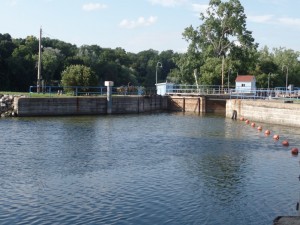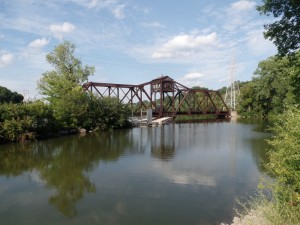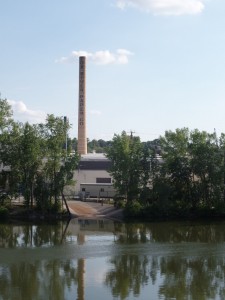Learning the Land: Our Driving Force
Namesake of the Fox Cities, the Fox River has been the most influential natural factor in the human history of the area. A vestige of the glaciers that covered much of Wisconsin, the river provided the region with a means of transportation between the Great Lakes and the Mississippi River system, as well as power for industrial practices. Without that connector, and the abundance of hydro power, the Fox Cities would never have been.
As discussed in the earlier post on glaciers, the Fox Cities area was once submerged beneath Glacial Lake Oshkosh. The Fox River, after the glaciers receded, cut through the ancient lakebed full of silt and clay, difficult material to grow crops in. At its largest, Glacial Lake Oshkosh would extend all the way from Green Bay to Portage, in the heart of Wisconsin. The Fox River, not coincidentally, extends for the same distance, the key to its historical importance.
At Portage, a mere two miles separates the Fox River and the Wisconsin River. A tributary of the Mississippi River, the Wisconsin River’s proximity to the Fox here allowed, with relative ease, the portaging of goods between waterways. The aptly named town served as the site where goods could be transported from the Great Lakes system to the Mississippi River system. Until railroads became the main source of transportation in the country, this route was the premier connection between the Great Lakes and the Mississippi.

One of the many locks that still manage the river over its drop between Lake Winnebago and Green Bay.
While the Upper Fox was never deep or wide enough to make the Fox River a main shipping causeway, it heavily influenced the human population in the area, with cities springing up along its banks. Between Lake Winnebago and Green Bay, the Fox drops about 170 feet in around 37 miles. This drastic drop, which happens in segments particularly large around Appleton, allows power to be harnessed from the river. Gwen Shultz, in Wisconsin’s Foundations, says, “No other river in Wisconsin produces so much power in so short a distance.“
The outstanding energy capabilities of the Fox River led to the dense industrialization along its banks that would see the Fox Cities form. The paper industry became particularly powerful in the region, due to the proximity of forests to the river. The lakebed of Glacial Lake Oshkosh made agriculture difficult in the Fox Cities, allowing the area to focus on the industrial practices that the river powered.
While heavily influential and an economic driver since the 1800s, the industrialization along the Fox has caused notable damage to the river as well. The multitude of paper mills, smelters, wood manufacturers, and other businesses over time have caused waste to be dumped into the river at an alarming rate. Particularly damaging to the river was the contamination by PCBs, man-made chemicals that pose risks to humans, animals, and the environment. While the production of PCBs was banned in 1976, there is a continued presence of the chemicals in the ecosystem.
The Fox River is the reason the Fox Cities exist. Because of a fluke of topography at Portage, goods could be transported between the Great Lakes and the Mississippi. Not only that, the river powered the industrialization along the banks of the Fox, particularly between Lake Winnebago and Green Bay. A great example of something seemingly so geologically simple – a river cutting into an ancient lakebed – turning out to be incredibly influential on later human development, we owe the Fox much.
Information from: Wisconsin’s Foundations: A Review of the State’s Geology and Its Influence on Geography and Human Activity by Gwen Schultz; http://ua.dnr.wi.gov/topic/ImpairedWaters/FoxRiver/original/pcbhistory.html.













Leave a Comment